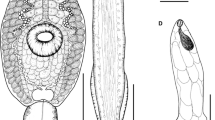Abstract
The echinostomatid trematodeEchinochasmus leopoldinae n. sp. is described on the basis of adults found in the intestine of chicks and mice experimentally infected with metacercariae from the gills of the cichlid fishesCichlasoma urophthalmus andC. synspilum from the Peninsula of Yucatan.E. leopoldinae, which had previously been misidentified asE. zubedakhaname Nasir & Díaz, 1968, is characterised by the presence of 20 collar spines with one angular spine on each side and vitelline follicles confluent in the posterior part of the body. A differential diagnosis ofEchinochasmus species possessing 20 collar spines is provided, and the developmental stages (redia, cercaria, metacercaria and adult) ofE. leopoldinae are described.
Similar content being viewed by others
References
Beaver, P.C. (1941) The life history ofEchinochasmus donaldsoni n. sp., a trematode from the pied-billed grebe.Journal of Parasitology, 27, 347–355.
Bykhovskaya-Pavlovskaya, I.E. (1969)Parasitological investigations into fish. Leningrad: Nauka, 108 pp. (In Russian)
Lamothe-Argumedo, R. & Aguirre-Macedo, M.L. (1991a) Tremátodos de Aves. IV. Estudio deEchinochasmus zubedakhaname (Trematoda: Echinostomatidae) recuperados experimentalmente.Anales del Instituto de Biología, Universidad Autónoma de México, Sèria Zoología, 62, 11–16.
Lamothe-Argumedo, R. & Aguirre-Macedo, M.L. (1991b) Metacercaria deEchinochasmus zubedakhaname parásito deCichlasoma urophthalmus en Celestún, Yucatán, México.Anales del Instituto de Biología, Universidad Autónoma de México, Seria Zoología, 62, 139–140.
Nasir, P. & Díaz, M. (1968) Studies of the freshwater larval trematodes. XVII. The life cycle ofEchinochasmus zubedakhaname n. sp.Zeitschrift für Parasitenkunde, 30, 126–133.
Scholz, T., Lavadores, J.I., Vargas, V.J., Mendoza, F.E., Rodríguez, C.R. & Vivas, R.C. (1994) Life cycle ofOligogonotylus manteri (Digenea: Cryptogonimidae), a parasite of cichlid fishes in Southern Mexico.Journal of the Helminthological Society of Washington, 61, 190–199.
Scholz, T., Pech-Ek, M.C.F. & Rodríguez-Canul, R. (1995a) Biology ofCrassicutis cichlasomae, a parasite of cichlid fishes in Mexico and Central America.Journal of Helminthology, 69, 69–75.
Scholz, T., Vargas-Vázquez, J., Moravec, F., Vivas-Rodríguez, C., & Mendoza-Franco, E. (1995b) Cenotes (sinkholes) of the Yucatan Penisula, Mexico, as a habitat of adult trematodes of fish.Folia Parasitologica, 42, 27–37.
Scholz, T., Vargas-Vázquez, J., Moravec, F., Vivas-Rodríguez, C., & Mendoza-Franco, E. (1995c) Metacercariae of trematodes of fish from cenotes (sinkholes) of the Yucatan Peninsula, Mexico.Folia Parasitologica, 42, 173–192.
Yamaguti, S. (1971)Synopsis of digenetic trematodes of vertebrates. Parts I, II. Tokyo: Keigaku Publishing Co., 1074 pp. + 347 pl.
Yamaguti, S. (1975)A synoptical review of life histories of digenetic trematodes of vertebrates. Tokyo: Keigaku Publishing Co., 590 pp. + 219 pl.
Author information
Authors and Affiliations
Rights and permissions
About this article
Cite this article
Scholz, T., Ditrich, O. & Vargas-Vázquez, J. Echinochasmus leopoldinae n. sp. (Trematoda: Echinostomatidae) and data on its life-cycle. Syst Parasitol 33, 157–165 (1996). https://doi.org/10.1007/BF01531196
Accepted:
Issue Date:
DOI: https://doi.org/10.1007/BF01531196




